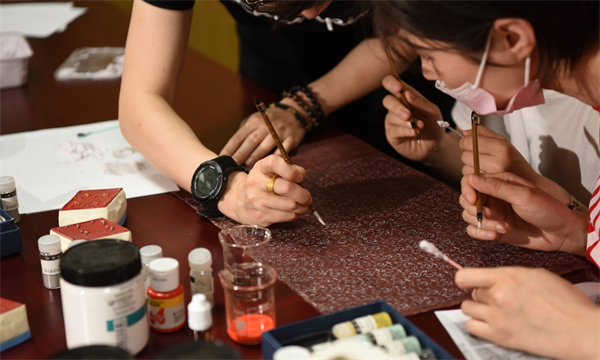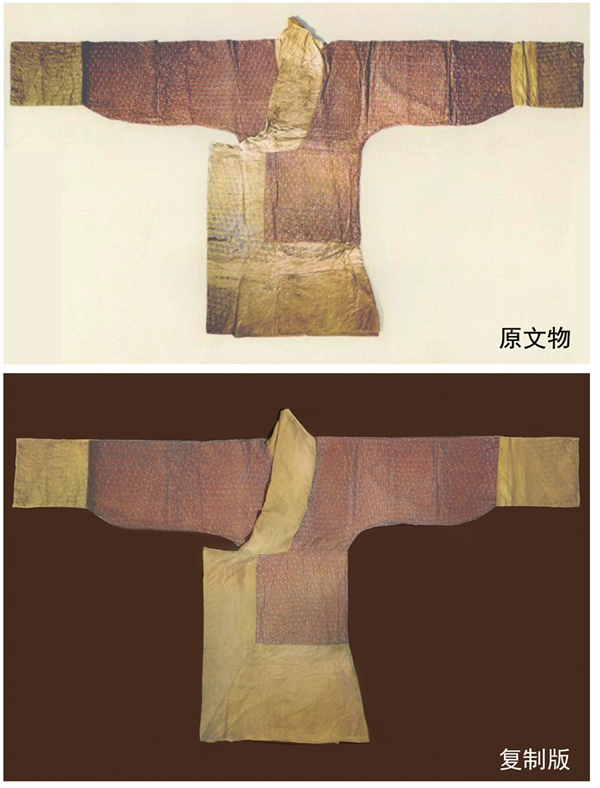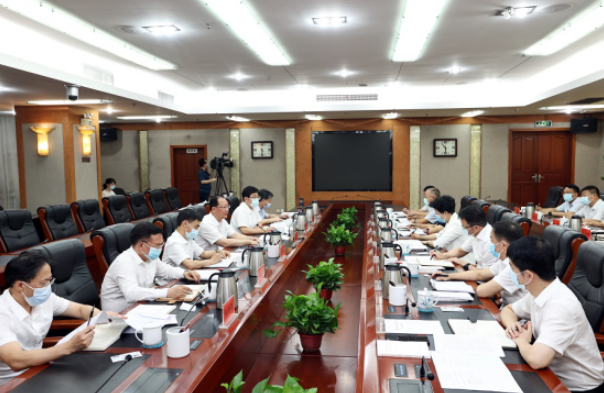Yang Jiyuan and her apprentices study the details of the drawings on a Western Han Dynasty robe. Photo: Courtesy of Nanjing Yunjin Research Institute Fifty years ago, three consecutive excavations were conducted in Changsha, Central China's Hunan Province, unveiling the Mawangdui Tomb, one of China's most sensational archaeological finds of the 20th century, dating back to the Western Han Dynasty (206BC-AD25). Yang Jiyuan, a restorer of ancient silk relics, had neither lived in Changsha nor taken part in the Mawangdui excavations. But behind the archaeological narrative, she is a character who has never been absent since two of the site's most precious silk garments were reproduced 1:1 by Yang and her team. 'Across time and space' Including the recent replica of a printed and painted floss silk padded gauze robe, Yang and her team reproduced another silk piece in 2019 called the plain unlined gauze gown, also known as Susha Danyi in Chinese. The two garments were identified as having belonged to Lady Xinzhui, or the Marquise of Dai. She was a fashion icon who possessed numerous pieces more than 2,000 years ago, and was known as the queen of luxury of her era. Li Cang, a high-level official of the Western Han Dynasty, was her husband and the owner of the Mawangdui Tomb. Led by Yang, the two replicas were completed by a silk restoration team at the Nanjing Yunjin Research Institute. The two pieces are currently housed at the Hunan Museum as part of its top-notch collections. Susha Danyi defines the "pinnacle of ancient silk artistry" and has long intrigued the public. The piece, weighing only 49 grams and as sheer as transparent paper, can be folded and placed inside a box half the size of an adult's palm. Compared to Susha Danyi's popularity, Lady Xinzhui's "padded gauze robe" is much more understated, yet Yang told the Global Times that the piece is actually even more refined than Susha Danyi since it was unearthed as one of China's first painted clothes, and also the world's earliest silk piece combining printed and painted patterns. "As professionals in the industry, we all know how groundbreaking the robe is. You can view it as another piece of Susha Danyi but covered with colors and drawings," Yang emphasized. For conservation purposes, the original robe has been well-preserved and prohibited from public viewing. In 2020, Yang and her team were commissioned to the 1:1 robe replica project. Their journey was not always smooth and the expert said she was "overwhelmed" by the extremely refined ancient Chinese silk weaving. The robe is covered with a delicate magenta color and is decorated with patterns including flower buds, tassels, and branches that are painted in colors like red, dark blue, and white. The Western Han Dynasty padded gauze robe (above) and a replica (below) produced by Yang Jiyuan and her team Photo: Courtesy of Nanjing Yunjin Research Institute After an investigation of the original piece, Yang and her team were startled by the fact that the robe's air-like silk fabric actually consists of seven layers, and she told the Global Times that painting on each of them is like "painting on a layer of tissue paper that is one-third of the tissue's thickness." "We painted one layer after another under the microscope because of just how faint those patterns are, too delicate and densely covered all over the garment. We have no clue about how ancient craftsmen achieved this," Yang noted. She added that drawing the robe's patterns took two craftsmen half a year. Yet at her first attempt, Yang failed. She said that the replica appeared to be softer and sheerer than the original piece because the texture of its paints was "incorrect." "We discovered the paints used on the original piece were actually blended with glue-like substances that were able to enhance the fabric's surface, giving it a more structured look than other silk garments like Susha Danyi," Yang said. After more than two years of meticulous work, the piece was finally duplicated with around 98 percent accuracy. While feeling the pride of her team, Yang said that she was even more touched by the dedication displayed in ancient Chinese craftsmanship. "Touching the piece is like conversing with Western Han Dynasty craftsmen across space and time without words. I felt a great sense of responsibility to carry on their legacies," Yang told the Global Times. Inheriting beauty The year 2024 marks the 18th year of Yang's work in the silk and textile conservation field. Aside from the Mawangdui site, Yang is an expert regularly invited by historical sites like the Palace Museum to carry out restoration projects. "I'm now working on making costumes for the miniature figurines on the western clocks imported to China in ancient times," she said. As an insider in the niche textile conservation field, Yang has seen the changes in the sector from lacking training and talent to its current state, which is strongly supported by national-level programs and regulations. She told the Global Times that her career would not have blossomed if she had missed the opportunity to join a training program launched by the National Cultural Heritage Administration in 2013. The program is dedicated to cultivating experts particularly in the sector of protecting and restoring the cultural relics of textiles. "We see a growing number of talents in sectors like porcelains, but professionals in restoring textile relics are still scarce," Yang emphasized. Experts like Yang may be fortunate to have been selected by such programs 11 years ago, but such initiatives have become more popular in recent years. Now Talent training programs for textile conservation are not only carried out by exhibiting facilities like the Palace Museum, but also by educational institutions like the Zhejiang Sci-Tech University. As an experienced craftsperson herself, Yang told the Global Times that she also feels responsible for passing her talents onto young apprentices. "I'm glad to see that there are many young people still willing to take part in preserving the traditional Chinese culture," she said. 

Experts Revive Mawangdui Silk Gowns, Extending Ancient Craftsmanship to New Era
Editor:谭婕倪
Source:enghunan.gov
Updated:2024-05-29 10:06:59
Source:enghunan.gov
Updated:2024-05-29 10:06:59
Special
Contact
Welcome to English Channel! Any suggestion, welcome.Tel:0731-82965627
lisl@rednet.cn
zhouqian@rednet.cn











